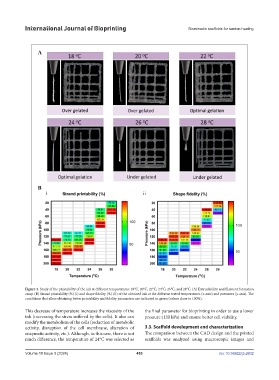Page 461 - IJB-10-3
P. 461
International Journal of Bioprinting Biomimetic scaffolds for tendon healing
Figure 3. Study of the printability of the ink at different temperatures: 18°C, 20°C, 22°C, 24°C, 26°C, and 28°C. (A) Extrudability and filament formation
assay. (B) Strand printability (%) (i) and shape fidelity (%) (ii) of the obtained ink at the different tested temperatures (x-axis) and pressures (y-axis). The
conditions that allow obtaining better printability and fidelity parameters are indicated in green (values close to 100%).
This decrease of temperature increases the viscosity of the the final parameter for bioprinting in order to use a lower
ink (increasing the stress suffered by the cells). It also can pressure (120 kPa) and ensure better cell viability.
modify the metabolism of the cells (reduction of metabolic
activity, disruption of the cell membrane, alteration of 3.3. Scaffold development and characterization
enzymatic activity, etc.). Although, in this case, there is not The comparison between the CAD design and the printed
much difference, the temperature of 24°C was selected as scaffolds was analyzed using macroscopic images and
Volume 10 Issue 3 (2024) 453 doi: 10.36922/ijb.2632

